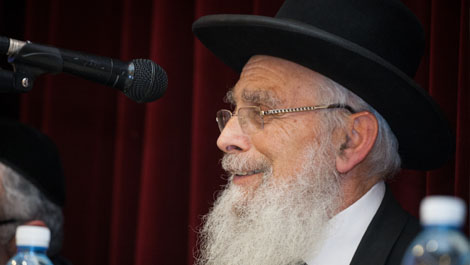Beit Midrash
- Sections
- Chemdat Yamim
- Bemare Habazak - Rabbis Questions
- Shabbat and Holidays
- Jewish Holidays
- Simchat Torah and Shmini Atzeret
Answer: During shiva, an avel is not supposed to learn Torah, and therefore he should not get aliyot, even on Shabbat, when one should not engage in aveilut publicly, because not getting called for an aliya is not noticeable (Shulchan Aruch, Yoreh Deah 400:1). However, if one was called for an aliya or gets an aliya every week, then he should do the aliya even on Shabbat during shiva because otherwise it would be public aveilut (ibid.). After shiva, there are generally no restrictions on aliyot, including "coveted" aliyot (e.g., Shlishi).
It is proper for an avel to be chazan during the first 11 months of aveilut for parents, thereby bringing merit to the deceased (Rama, YD 376:4). Yet on Shabbat and Yom Tov an avel does not serve as chazan (ibid.) because it is inappropriate for him to lead festive tefillot. There is discussion as to whether it might be appropriate for the more somber tefillot of Yamim Noraim. The Shach (YD 376:14) rules based on the Rama’s sources that, unless there is a special need, they should not because they also are largely festive. (Another possible factor regarding Yamim Noraim is to avoid having a chazan upon whom the attribute of din is hovering (Mateh Ephrayim 581:23).)
There are significant opinions that there is no real prohibition for an avel to be chazan on Shabbat and Yom Tov. The Noda B’Yehuda (I, OC 32) says it is a minhag, not a full halacha. The Meir Netivim (cited by Pitchei Teshuva, YD 376:8) claims that the halacha is that he is just not instructed to be chazan because of his aveilut (like during the week) but that one who is regularly a chazan on Shabbat does not have to stop during his aveilut.
However, according to the mainstream approach, even an intrinsically permitted role in a mitzva be improper for an avel if its context is festive. Similarly, the Rama (Orach Chaym 660:2) rules that an avel (throughout 12 months for a parent) should not encompass the bima with a lulav on Sukkot (not all agree, and some distinguish between different days of Sukkot – see Gesher Hachayim 23:3.7). Regarding Simchat Torah, Acharonim disagree about participation in Hakafot. The Gesher Hachayim (ibid.) says he can go around with the sefer Torah but not participate in the subsequent dancing.
Most Acharonim posit that the aliya of chatan Torah is too festive to allow for an avel (see P’nei Baruch 29:11). However, the uncertainty of this determination and lack of severity of the matter opens room for leniency in certain cases. One such case is when one was appointed or won the right to be chatan Torah before becoming an aveil, and the question is if he must give it up. The Zera Emet (YD 162) first forbids the aliya, then explains why it could be permitted, and finally recommends not doing it. The Yalkut Yosef (Aveilut 22:22) permits it under such circumstances, based on the weakness of the problem, especially after shiva. Another factor that is reason to be lenient is the matter of public aveilut by refraining, after the chatan Torah aliya has been set. However, in cases where nothing is set, it is proper to wait for a year without aveliut to honor someone.
One situation in which it may be best to allow an avel to have chatan Torah is when he receives it every year (in some places, the rabbi). Then, withholding it could be a public display of aveilut. On the other hand, there are serious opinions (including the Shach 400:2) that public aveilut is forbidden only for practices of first-level aveilut (i.e., practices that are just for shiva) and not those of minimizing joy (i.e., those that apply all year). Still, avoiding public displays of even year-long aveilut is mentioned in many halachic discussions (see Gesher Hachayim ibid., Chazon Ovadia, Aveilut II, p. 365). If, in the final analysis, an avel will get chatan Torah, it is a good question whether the festivity surrounding his aliya should be toned down (see Zera Emet, ibid.).

Bemare Habazak - Rabbis Questions (627)
Various Rabbis
153 - Havadala on Yom Kippur Which Falls on Shabbat
154 - A Mourner Serving as Chatan Torah
155 - Mistakes in the Order of Kaddish and Barchu
Load More

Ask the Rabbi: Omitting Tachanun in Selichot in the Presence of Simcha
Rabbi Daniel Mann | Elul 5785

Ask the Rabbi: Using Replacement Mezuzot When They Are Being Checked?
Rabbi Daniel Mann | Av 5785

Ask the Rabbi: Selecting Things to Use Later on Shabbat
Rabbi Daniel Mann | Iyar 5785

Ask the Rabbi: Purim Meshulash
Rabbi Daniel Mann | Adar 5785

Rabbi Daniel Mann

Making Sure your Check Is Cashed
Kislev 5783

Bikur Cholim by Electronic Means
Shvat 1 5782

Reciting Borei Nefashot on Food When One Will Still Drink
Sivan 3 5780























